The Impact of Climate Change on Ice Sheets
Understanding Ice Sheets
Ice sheets, particularly those in Greenland and Antarctica, play a crucial role in regulating global sea levels. However, recent studies indicate that these massive ice formations are melting at an alarming rate. Consequently, understanding the factors contributing to this accelerated melting is essential for predicting future sea level rise.
Greenland’s Changing Ice Sheet

The ice sheet in Greenland has increasingly become the largest contributor to global sea level rise. Recent satellite data reveal that the melting is occurring at an unprecedented speed, primarily during the summer months due to rising temperatures.
The Role of Microbes
Surprisingly, microscopic life forms significantly affect the melting of ice sheets. For instance, a type of algae found on glacier surfaces absorbs sunlight, thereby accelerating ice melt. Studies led by scientists, including those from the UK’s National Environmental Research Council project “Black and Bloom,” are currently examining how these microbes impact ice albedo—the reflective capacity of ice—which in turn influences the melting process.

Antarctica’s Ice Mass Loss
In Antarctica, the situation is similarly dire as blocks of ice calve into the ocean, a trend that has intensified due to climate change. This ice mass loss, coupled with surface melting, is significantly altering the continent’s landscape and its contribution to the global sea level.

The Arctic Ecosystem
The ecosystem in the Arctic region is experiencing rapid changes as well. For instance, warming temperatures are leading to a reduction in snow cover, exposing more ice to sunlight, which creates favorable conditions for microorganisms.

Conclusion
In conclusion, the dynamics of both Greenland’s and Antarctica’s ice sheets reveal vital information about our planet’s climate system. The interplay between microbial activity and climate conditions plays a significant role in influencing ice melt rates. Therefore, ongoing research is essential to understand these changes and their implications for global sea levels and ecosystems.




